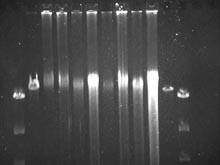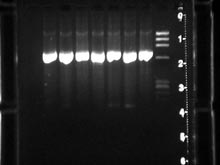
In a process called electrophoresis, DNA is loaded into agarose gel. This enables the microbiologist to see the DNA. Photos courtesy of Harbor Branch Oceanographic Institution. Click image for larger view.
Molecular Biology in Marine Research
Jane Thompson
Division of Biomedical Marine Research
Harbor Branch Oceanographic Institution
Molecular biology techniques are important new tools for exploration and excavation of the ocean. These new research tools will answer questions about ecology, biodiversity, evolutionary genetics and systematics of marine organisms. Additionally, the marine environment is a tremendous resource for yet to be discovered bioactive natural products.
Natural products are chemical compounds that provide new sources of antibiotics, antitumor compounds and anti-inflammatory agents. Since 30% of the drugs now being used are based on natural products, the marine environment is very important for new discoveries of drug sources and cures for disease. Most scientists recognize that collections from the sea should be limited, and harvesting of the world's oceans is likely to deplete overall resources. Important to every phase of research is the sustainable use of ocean resources. Molecular techniques make this possible through the isolation of important genes and the production of biomedical compounds through recombinant technology.
The techniques now being employed include DNA extraction, RNA extraction, the use of agarose gel electrophoresis to visualize DNA and RNA, polymerase chain reaction (PCR), and sequencing for genes of interest. As a result of ocean exploration and research, genomic libraries can be created to preserve all of the genes (DNA) found in marine organisms. From genomic libraries, a gene that makes an important biomedical compound can be cloned and expressed as a chemical compound in an artificial system.
The Process
The molecular biologist begins his or her research when samples of marine organisms reach the surface. The samples are given a unique identifying number and small pieces (1-2 grams) are quickly frozen. The frozen sample is later thawed at 4° C and homogenized in an extraction buffer that dissolves all the cell's membranes to release nucleic acids (DNA and RNA). An organic extraction is performed to remove proteins, fats, and other organically soluble compounds, leaving nucleic acids in the aqueous solution. Nucleic acids can then be mixed with ethanol and stored for the trip back to the laboratory.
After resuspending the stored samples, a process called electrophoreses is used to visualize the DNA extractions and determine their concentration. Agarose is a product derived from algae that can be heated to a liquid, poured into a mold and cooled to a solid gel. Small indentations are made in the hot liquid; this produces a "well" into which the DNA can be loaded when the gel solidifies. The gel is placed under a salt buffer, and an electrical charge is applied from one end of the gel to the other. This allows the microbiologist to see the DNA and estimate its concentration or amount. Once the DNA concentration is known, other techniques can be employed. Polymerase chain reaction (PCR) is an important technique for establishing the presence of a particular gene in an organism. Small amounts of the sequence of that gene must be known. These known sequences (primers) serve to prime the reaction that amplifies the gene of interest.
For example, in the search for new antitumor compounds, primers from a conserved class of antitumor compounds can be used to find the presence of this type of gene in new organisms. PCR may also establish the unique identity of a marine organism. The regions employed to establish identity are usually ribosomal RNA genes from microbes (16S) or from invertebrates (18S). The product of this PCR is then sequenced, resulting in a unique pattern of individual base pairs (ACTG).
The oceans remain our last great frontier of research. The potential for discovery is tremendous. Molecular biology provides exciting new tools for discoveries that will advance biology, biochemistry, and medicine.























